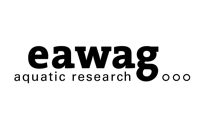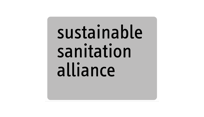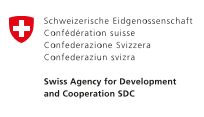Solid waste products refer to the wide range of different domestic solid waste streams generated in a humanitarian context (often also referred to as primary products) and the various products generated as part of the SWM process (so-called secondary products). For the design of a robust SWM service chain, it is necessary to identify all the products that are flowing into (inputs) and out of (outputs) each of the technologies of the chain. Liquid waste, such as human excreta and wastewater, is intentionally not included and should never enter the SWM service chain.
Primary Products
Organic Waste: refers to any organic matter that can be broken down by microorganisms into their constituent elements and compounds. It commonly consists of plant and animal matter, kitchen waste (such as food scraps, trimmings and spoiled food) and food market waste. It can be decomposed during aerobic and anaerobic processes and transformed into valuable resources like biogas [T.3], compost [T.1], fuel [T.5] or animal feed and frass [T.4]. Using processed organic waste in agriculture [U.5] enables the recirculation of nutrients and carbon for plant growth. Organic materials which take longer to decompose, such as wood or bamboo, can be used to produce solid fuels [U.7]. Separating and processing organic waste helps to reduce the volume of waste sent to disposal sites and reduces the emission of flammable and greenhouse gases from deposited waste. It contributes to more environmentally friendly waste management practices and to reducing public health risks. Organic waste can be further differentiated into fast-degrading Organic Food/Kitchen Waste and slower-degrading Organic Garden/Wood Waste (see detailed description below). Organic waste is often also referred to as “biodegradable waste”.
Organic Garden/Wood Waste: refers to the slower-degrading fraction of organic waste that is generally more fibrous than food waste. It commonly consists of bamboo, nut shells, sawdust, agricultural residues, twigs, branches and (untreated) timber and construction wood. It has a high carbon content, which makes it an important component in composting [T.1]) and vermicomposting [T.2] for balancing the carbon-to-nitrogen (C:N) ratio and is a valuable source for producing solid biomass fuel [T.5].
Organic Food/Kitchen Waste: refers to any fast-degrading organic matter that can be broken down by microorganisms into their constituent elements and compounds. It commonly consists of food scraps, trimmings, leftover and spoiled food, and food market waste. It is rich in nutrients, particularly nitrogen, phosphorus and potassium, making it suitable for composting [T.1] to produce nutrient-rich compost. It can be decomposed during aerobic and anaerobic processes and transformed into valuable resources like biogas [T.3, compost [T.1], or animal feed and frass [T.4]. Using processed organic food/kitchen waste in agriculture [U.5] enables the recirculation of nutrients for plant growth. Separating [P.2] and processing organic waste helps to reduce the volume of waste sent to disposal sites, reduces the emission of flammable and greenhouse gases from deposited waste and contributes to more environmentally friendly waste management practices [X.8].
Recyclables: are mainly non-biodegradable materials that can be collected, processed and reused to create new products. Recycling these materials involves sorting, cleaning and processing them so that they can be used as raw materials to produce new goods. Recycling indicates that the produced new goods have comparable material properties and functions as the original material. The reuse of materials to produce items with reduced material properties is termed ’downcycling’ [T.8], while ’upcycling’ [T.7] describes the artistic and creative reuse of waste materials with the potential to increase their quality or value. Recycling waste is a key component of SWM, helping to conserve natural resources, reduce energy consumption and decrease the environmental impact associated with the extraction and production of new materials. Recyclable waste typically includes paper and cardboard, glass, metals, plastics or textiles (see detailed description below). However, whether a material can be categorised as “recyclable” depends on the location, as recycling is driven by regulatory requirements and economic interests. While it may be technically feasible to recycle the above-mentioned materials, the recycling infrastructure and service chain may not be in place in a particular location.
Plastics: refers to synthetic or semi-synthetic material made from a wide range of organic polymers. Different plastic types are distinguished by their polymers, including Polyethylene (PE), High-Density Polyethylene (HDPE), Polyvinyl Chloride (PVC), Polyethylene Terephthalate (PET), and various others. If a plastic item only consists of one plastic type, it is potentially recyclable. The feasibility, complexity and economic incentive to recycle depends on the plastic type and cleanliness of plastic waste. If plastics are mixed with other materials, such as metal coating or cardboard, they are considered composite materials. While the recycling of composite materials might be technically feasible, it might not be of economic interest, and composite materials are therefore commonly considered non-recyclable. Plastic waste includes plastic packaging, bottles, containers and other products made from plastic materials. Plastic waste poses environmental challenges due to its persistence and potential for pollution. Recycling involves collecting, sorting and processing plastic waste to manufacture new plastic products.
Paper or Cardboard: encompasses products from cellulose fibres such as cardboard or paper packaging, newspapers, magazines or office paper. Processed cellulose fibre originates from wood, grasses or other plant sources. However, as paper or cardboard also contains non-biodegradable auxiliary materials (such as colour pigments, glue or lamination), they are not commonly listed as biodegradable materials. Paper or cardboard is considered recyclable waste that can be collected, processed and reused to create new products. The recycling of paper and cardboard is a common practice, and these materials are often collected separately from other waste streams to facilitate the recycling process.
Metals: refer to a range of materials which are made completely or mostly of metal material such as copper, aluminium or iron. Metal waste includes items such as aluminium cans, steel packaging and scrap metal from construction or manufacturing processes. Metals are valuable materials that can be recycled repeatedly without significant loss of quality. The recycling of metal waste involves collecting, sorting and processing these materials for reuse in manufacturing new metal products.
Glass: refers to a solid, brittle and often transparent material. Silica is commonly its main component and the main glass-forming constituent, but depending on function and colour, glass can also contain other constituents such as soda, lime, metals and other fining agents. Glass waste includes used glass bottles, jars, containers, or other consumer products made of glass. Glass recycling can be conducted with both intact and broken glass items. It involves the separate collection of used glass and its melting to produce new glass products. Different glass colours and glass types, which are used for different functions and contain different additives (e.g. glass used as beverage containers, window glass, or laboratory glass), may need to be collected separately.
Textile: refers to materials made from natural or synthetic fabrics. Textile waste includes worn-out clothing, household textiles and manufacturing scraps. Recycling initiatives often focus on collecting and processing textile waste for reuse, either through transforming textiles into new products or converting them into fibres for use in various applications.
Mixed Waste: refers to a combination of various types of waste materials that are commingled and disposed of together and that are difficult to separate. This waste stream typically includes a mixture of biodegradable, non-biodegradable, recyclable and non-recyclable materials. Mixed waste may include a diverse range of items such as food scraps, paper, plastics, glass, metals and other miscellaneous waste. Managing mixed waste can be challenging because the separate handling of different waste components is not possible unless labour-intensive sorting is done. Hence, effective waste management strategies aim to encourage source segregation, with the separation of recyclable and biodegradable materials from non-recyclables, reducing the complexity and environmental impact of mixed waste disposal [P.2]. The advantage of the initial source segregation is that reusable and recyclable resources are not soiled by the entire waste matrix. This simplifies their further processing and commonly leads to higher prices for the sale of recyclables. A specific form of mixed waste is litter, which is small pieces of rubbish or discarded items that are improperly disposed of in public places. Litter commonly includes items such as food wrappers, cigarette butts, beverage containers and other small items left in outdoor areas, parks, streets, or public spaces. It is also prone to end up in drainage and stormwater systems and can lead to blockages or reduced drainage efficiency.
Residual Waste: refers to the waste that remains after materials that can be reused, recycled or composted have been separated and removed. It includes items that are typically disposed of in landfills or incinerated in municipal waste incineration plants. Residual waste encompasses a variety of materials, such as composite plastics, mixed waste and other items that are challenging to recycle or do not have established recycling markets. Reducing the generation of residual waste through waste minimisation and recycling efforts is a key goal in sustainable waste management practices. Waste-to-energy technologies are sometimes employed to generate energy from the incineration of this waste. However, this approach is mainly found in high-income settings as municipal waste incineration is expensive, complex and high maintenance and the generated energy is costly compared to other energy sources.
Secondary Products
Compost: refers to decomposed biodegradable matter that results from a controlled aerobic degradation process [T.1]. In this biological process, microorganisms (mainly bacteria and fungi) decompose the biodegradable waste components and produce an earth-like, odourless, brown/black material. Compost has excellent soil amendment properties and a variable nutrient content. Because of leaching and volatilisation, some of the nutrients may be lost, but the material remains rich in plant-available micro and macronutrients and organic matter. Generally, the composting process should be long enough (2 to 4 months) under thermophilic conditions (55 to 60 °C) to sanitise the compost sufficiently for safe agricultural use.
Vermicompost: refers to a type of compost produced through the breakdown of organic waste by earthworms. In this process [T.2], earthworms consume organic materials such as food scraps, agricultural residues and other biodegradable waste. As they digest this material, the worms produce castings or worm excrements rich in nutrients and beneficial microorganisms.
Animal Feed: either refers to nutritious biodegradable waste, ideally free from impurities and pathogens, for animal nutrition. Alternatively, it can refer to the indirect usage of biodegradable waste, for instance, the usage of Black Soldier Fly (BSF) larvae grown on biodegradable waste [T.4]. Animal feed derived from solid waste contains nutrients such as protein, carbohydrates, fats, vitamins and minerals and can be produced from biodegradable solid waste such as food waste, crop residues, food processing waste or animal manure.
Frass: refers to the waste products or excrement produced by insects, particularly larvae that feed on plants or organic material [T.4]. It is rich in nutrients and organic matter which are beneficial to plants. It is typically used as a fertiliser or soil amendment and can help improve soil health by adding organic content and beneficial microbes.
Solid Biomass Fuel: mainly derives from biodegradable garden/wood waste that has a higher cellulose content such as wood, bamboo, nut shells, sawdust and agricultural residues. While larger pieces of wood or bamboo can be directly used as fuel, smaller and more dense or powdery materials will burn less efficiently or not at all. These biomass wastes can be processed into pellets or carbonised or non-carbonised briquettes [T.5]. To produce pellets, crushed biomass is pressed into small granules with the natural lignin acting as a binder. For carbonised briquettes, biomass waste is transformed into charcoal, crushed into charcoal powder and compacted into briquettes with the use of additional binding agents. For non-carbonised briquettes, crushed biomass is directly mixed with binding agents and compressed. It is important to note that many of the stoves used to burn biomass fuels do not lead to clean cooking according to guidelines of the World Health Organization. The only exception might be the fan-based pyrolysis of biomass pellets in specialised stoves.
Biogas: is the common name for the mixture of gases released from the anaerobic digestion [T.3] of organic material. Biogas comprises methane (50 to 75%), carbon dioxide (25 to 50 %) and varying quantities of nitrogen, hydrogen sulphide, water vapour and other components, depending on the material being digested. Biogas can be collected and burned for fuel.
Digestate: is a by-product that remains after the anaerobic digestion [T.3] process, in which organic material is broken down by microorganisms in the absence of oxygen into biogas (a mixture of methane and carbon dioxide) and digestate. The digestate is a nutrient-rich slurry that typically includes organic matter, macronutrients such as nitrogen, phosphorus, potassium and micronutrients beneficial to soil health. The composition of digestate can vary depending on the type of feedstock used in the anaerobic digestion process. It can be used as a fertiliser, or soil conditioner or can be further composted.
Products from Processed Plastic: both single-type and composite plastic waste used in plastic bottles, containers, packaging materials and single-use items can be used to produce a wide range of new products. Three different approaches to plastic processing exist, and they differ in the properties, functionality and value of their end-products compared to the initial material. Recycling refers to the process where the end-product is of similar value and functionality as it originally was (e.g. using waste plastic items to make new plastic items); it is limited to single-type plastic waste. Upcycling [T.7] refers to a higher value end-product and downcycling [T.8] leads to an end product with lower value and functionality. Both upcycling and downcycling can use single-type and composite plastic waste, depending on the type of process. Recycling, and in some cases downcycling, requires the thermal modification of the raw material. It includes sorting, cleaning, shredding, melting and forming into granules and the moulding of granules into new products (by extrusion moulding, injection or compression moulding). Thermal modification must always be limited to single-type plastic waste. For downcycling, plastic waste might be mixed with other substances, such as sand, before thermal modification.
Other Specific Waste Types
Medical and Health Care Waste: refers to waste materials generated by health care activities (such as waste produced in hospitals, clinics, dental practices, veterinary clinics, medical research facilities and laboratories). It also includes domestic-like waste that can be separated and managed as part of domestic or municipal SWM. Medical and health care waste includes a wide range of materials, some of which are hazardous to human health and the environment if not properly managed. It may include infectious waste, sharps, needles, syringes and other sharp objects, pathological waste and pharmaceutical, chemical and/or radioactive waste that must be managed separately [W.1]. In addition, medical and health care facilities produce domestic-like waste that can be separated and managed as part of the domestic or municipal SWM service chain.
Hazardous Waste: refers to waste that contains materials posing a potential threat to human health or the environment. These materials often exhibit the characteristics of toxicity, flammability, corrosiveness or reactivity. Examples of hazardous household waste include certain cleaning products, paints, solvents, pesticides, batteries and electrical and electronic devices. The proper disposal of hazardous domestic and municipal waste is essential to prevent environmental contamination and to protect the health and safety of waste handlers and the public [W.2].
Disaster Waste: includes all solid and liquid waste generated from a natural disaster or conflict, both during the event itself as well as in the emergency response and recovery phases. It is characterised by typically large waste quantities, a mixture of various waste types and a strongly intertwined waste matrix, which further complicates its management [W.3]. It can include debris from damaged buildings and infrastructure, vehicles, hazardous substances, e-waste, unmanaged medical waste and domestic solid waste.
Menstrual and Incontinence Waste: refers to discarded items used for managing menstruation or incontinence, including products such as sanitary pads, tampons, panty liners and infant and adult diapers. This waste stream poses unique challenges due to the nature of the materials involved. Managing this waste requires both hygiene considerations and environmental impact to be addressed, as improper disposal can contribute to pollution and sanitation issues. Waste management practices for menstrual and incontinence products include dedicated collection systems, exploring environmentally friendly treatment options such as composting or recycling where feasible, and safe disposal methods. Public awareness and education are essential components of responsible waste management in this context [W.4].
Relief Waste: refers to all waste generated by humanitarian relief operations, often also referred to as humanitarian waste [W.5]. This includes the waste generated by the humanitarian services provided, such as food waste, packaging materials, shelter waste and other Non-Food Items, and waste from the organisations’ functional services in offices, guest houses, warehouses and vehicle workshops.
Solid Waste from Sanitation Facilities and Drains: refers either to waste that has been directly discarded into sanitation systems (such as pits or septic tanks) or to solid waste and litter discarded in public spaces or streets that eventually accumulates in stormwater lines and drainage systems where it can lead to blockages, overflow, clogging of pipes and channels or stagnant water pools. The accumulation of solid waste in sanitation facilities is often due to a lack of other waste collection and management options. It can be comprised of a wide range of materials, including biodegradable matter (such as food waste), non-biodegradable materials (such as plastics, paper, glass, and metals), sanitary products (menstrual products or diapers), or debris. The removal of solid waste from sanitation facilities takes considerable effort (e.g. the manual removal from pits to facilitate proper pit emptying or waste screens in faecal sludge treatment plants). It contains a high faecal pathogen load, which requires corresponding treatment. Solid waste in drains may also consist of a wide range of materials, including biodegradable matter (such as food waste, leaves, and plant debris), non-biodegradable materials (such as plastics, paper, and metals), sediment, silt, sand and other debris. It may contain contaminants such as oils, grease, chemicals, pathogens and other pollutants, which can pose risks to human health and the environment if not properly managed [W.6].
e-Waste or Waste from Electrical and Electronic Equipment (WEEE): refers to discarded or obsolete electrical or electronic devices and appliances. E-waste includes a wide range of items such as computers, mobile phones, household appliances, lamps, photovoltaic panels and other electrical and electronic equipment. Due to the presence of toxic materials like heavy metals, e-waste must be considered as hazardous and posing a risk to public health and the environment; its safe recycling and disposal are critical. E-waste can also contain valuable commodities, including rare-earth metals, copper or gold. These can be recycled and reused if the waste is effectively managed. Improving the collection, treatment and recycling of electrical and electronic equipment at the end of their life can increase resource efficiency and support the shift to a circular economy [W.7].






